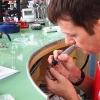-
Recently Browsing
- No registered users viewing this page.
-
Topics
-
Posts
-
By rossjackson01 · Posted
Been there. Worn that Tshirt. 'ping'. Hands and knees. Nothing. Nada. 20 minutes? Ha! I found it 7 month later. How? Well, after advice from a member, I invested in a £4 UV light torch. Hands and knees looking for a 'ping' from a Sekonda, found them both within 30 seconds. UV makes the jewel shine. easy peasy. Could have taken longer. Just lucky on the location of the search. Hope this helps. -
Thanks Dell. I thought about silver soldering. Have never done it but would like to give it a go. Do you think to put flux on the butted joint then run the solder in or to maybe brace it with a piece of scrap spring steel?
-
By rossjackson01 · Posted
Never and others. Yes, like you I do spend a fair amount of time reading the contents of this forum. I find it better that any other. Clear, lucid, no Prima Donas, and most of all an easy access without adverts. All thanks to Mark. God bless you mate. You give so much to many of us. What if? No Mark? Hypothetically. A forum. I did run a forum for a few years. Really enjoyed it, but became so engrossed that it did affect my health. I gave to to others to run. Not been back. It was very successful and rivalled a number of large paying sites. No adverts, no others but me. I did ask and listen to members comments and it worked well. Costs Having a domain name, £10 annually. Register the site with a forum company, free. Build the site using the forum company guide lines, free. It looked and ran almost the same a Mark's. All the same facilities. The cost was only £5 per month, but counted visits (views). If I recall, it was that price for 5,000 views. Each extra 5,000 views increased the price by £2 per month. Success was my own personal undoing. From £5 per month initially, it rose to £60 a month and looked like increasing. This was 10 years ago. I could not afford that, and asked it anyone would like to take over and someone did. I would assume that this is the price that Mark is funding for us all. His return is our continued comments on the internet about his course, and the fact that many of the big names on YouTube mention him as their Tutor. Those of us who have done, and are still using, his course, benefit. In comparison to other courses, I can't believe how cheap it is, and the value is exceptional. It is the structure that gives the value. Long may Mark reign. Ross






Recommended Posts
Join the conversation
You can post now and register later. If you have an account, sign in now to post with your account.
Note: Your post will require moderator approval before it will be visible.